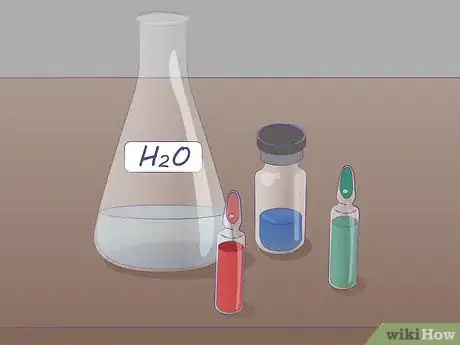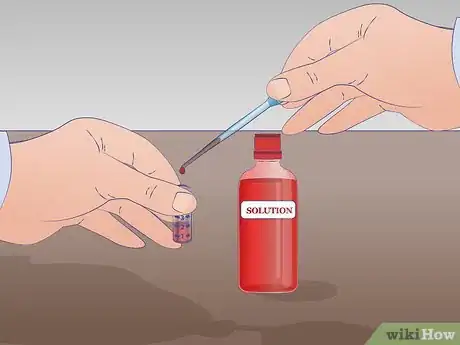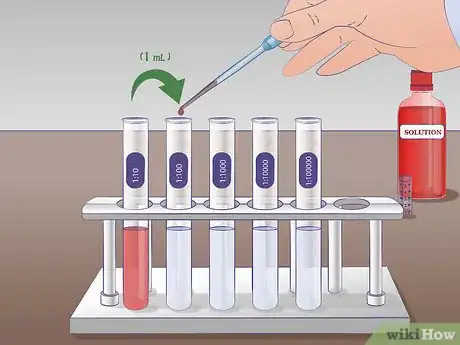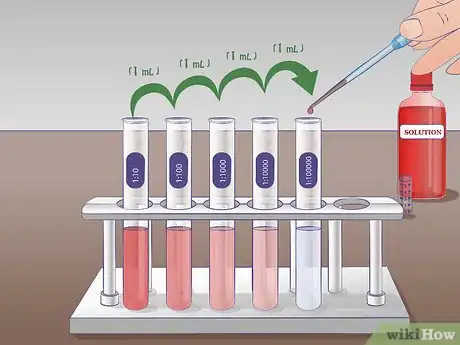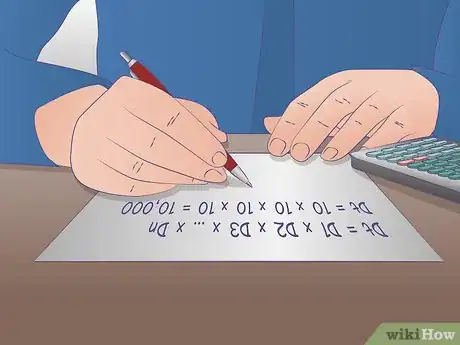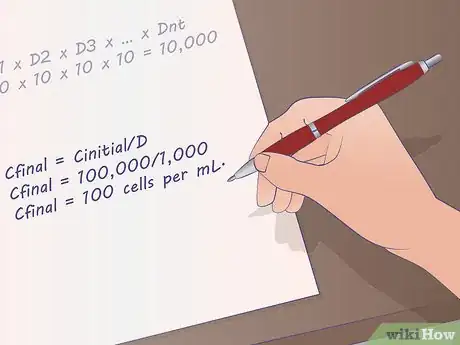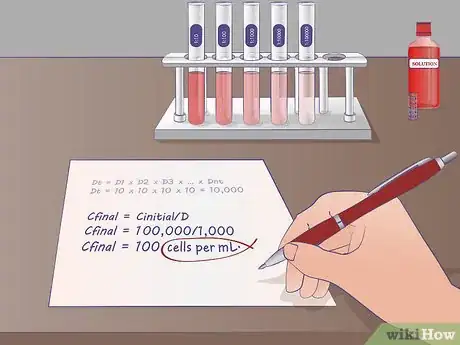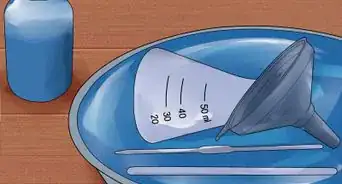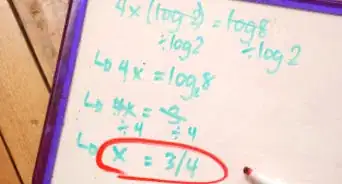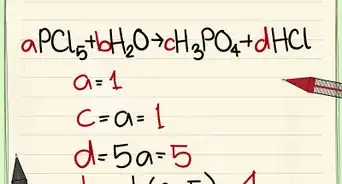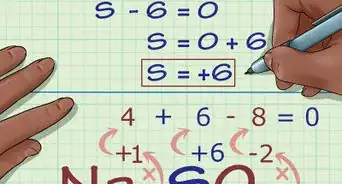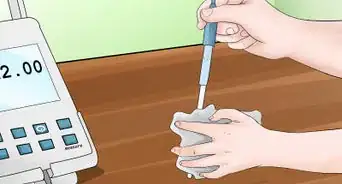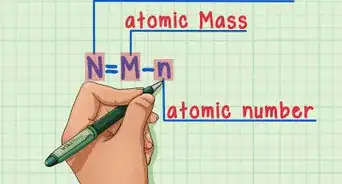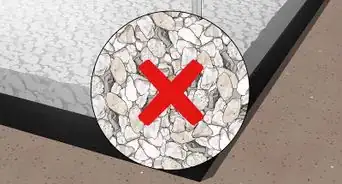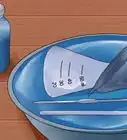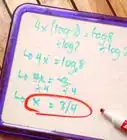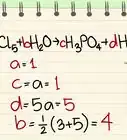This article was co-authored by Bess Ruff, MA. Bess Ruff is a Geography PhD student at Florida State University. She received her MA in Environmental Science and Management from the University of California, Santa Barbara in 2016. She has conducted survey work for marine spatial planning projects in the Caribbean and provided research support as a graduate fellow for the Sustainable Fisheries Group.
There are 7 references cited in this article, which can be found at the bottom of the page.
wikiHow marks an article as reader-approved once it receives enough positive feedback. This article has 18 testimonials from our readers, earning it our reader-approved status.
This article has been viewed 658,302 times.
A dilution in chemistry is a process that reduces the concentration of a substance in a solution. A serial dilution is the repeated dilution of a solution to amplify the dilution factor quickly.[1] It’s commonly performed in experiments requiring highly diluted solutions, such as those involving concentration curves on a logarithmic scale or when you are determining the density of bacteria. Serial dilutions are used extensively in experimental sciences like biochemistry, microbiology, pharmacology and physics.
Steps
Performing a Basic Dilution
-
1Determine the proper dilution liquid. The liquid that you will be diluting your substance in is very important. Many solutions will be diluted in distilled water, but this is not always the case. If you are diluting bacteria or other cells, you will likely want to dilute in culture media.[2] The liquid you choose will be used for every serial dilution.
- If you’re unsure what liquid to use, ask for help or check online to see if other people have performed a similar dilution.
-
2Prepare several test tubes with 9 mL of dilution liquid. These tubes will serve as your dilution blanks.[3] You will be adding your undiluted sample to the first tube and then serially diluting into the following tubes.
- It’s helpful to label all of your tubes before you begin so you don’t get confused once you begin with the dilutions.
- Each tube will be a 10-fold dilution starting from the undiluted tube.[4] The first tube will be a 1:10 dilution, the second a 1:100, the third a 1:1000, etc. Determine the number of dilutions you need to do beforehand so you don’t waste tubes or diluting liquid.
Advertisement -
3Prepare a test tube with at least 2 mL of your undiluted solution. The minimum amount needed to perform this serial dilution is 1 mL of undiluted solution. If you only have 1 mL you will not have any remaining undiluted solution. Label this tube US for undiluted solution.
- Thoroughly mix your solution before starting any dilutions.[5]
-
4Perform the first dilution. Draw 1 mL of undiluted solution from test tube US with a pipette and transfer it to the test tube labeled 1:10 containing 9 mL of the dilution liquid and mix thoroughly. There is now 1mL of the undiluted solution in 9 mL of the dilution liquid. The solution, therefore, has been diluted by a factor of 10.[6]
-
5Perform the second dilution. For the second serial dilution, you will take 1 mL of solution from tube 1:10 and add it to the 9 mL of dilution liquid in the tube 1:100. Thoroughly mix tube 1:10 before adding to the next tube. Again, mix the tube 1:100 following dilution. The solution from test tube 1:10 has been diluted 10-fold into test tube 1:100.[7]
-
6Extend this procedure to perform longer serial dilutions. This process may be repeated as many times as necessary to achieve the desired solution. In an experiment involving concentration curves, you can use a serial dilution to create a series of solutions with dilutions of 1, 1:10, 1:100, 1:1,000.
Calculating Final Dilution Factor and Concentration
-
1Calculate the final dilution ratio in a serial dilution. The total dilution ratio can be determined by multiplying the dilution factor of each step leading up to the final step. This can be mathematically illustrated with the equation Dt = D1 x D2 x D3 x … x Dn where Dt is the total dilution factor and Dn is the dilution ratio.
- For example, let’s say you did a 1:10 dilution of your liquid 4 times. Plug your dilution factor into the equation: Dt = 10 x 10 x 10 x 10 = 10,000
- The final dilution factor of the fourth tube in your serial dilution is 1:10,000. The concentration of your substance is now 10,000 times less than the original undiluted solution.
-
2Determine the concentration of the solution following dilution. To determine the final concentration of your solution following serial dilution you will need to know your starting concentration. The equation is Cfinal = Cinitial/D where Cfinal is the ending concentration of the diluted solution, Cinitial is the starting concentration of the original solution and D is the dilution ratio previously determined.[8]
- For example: If you started with a solution of cells with a concentration of 1,000,000 cells per mL and your dilution ratio is 1,000, what is the final concentration of your diluted sample?
- Using the equation:
- Cfinal = Cinitial/D
- Cfinal = 1,000,000/1,000
- Cfinal = 1,000 cells per mL.
-
3Confirm that all units match. When performing any calculation, you want to make sure that your units always match at the end.[9] If you started with cells per mL make sure you are ending with cells per mL. If your starting concentration is parts per million (ppm), then your final concentration must be ppm.
Community Q&A
-
QuestionHow can I compose 2% dextrose saline from 5% dextrose saline?
 Community Answerit depends on the volume of 2% dextrose to prepare: assuming you are to prepare 10ml, use the formula:c1v1=c2v2,where c- concentration and v-volume. 2x10=5xv, 20= 5v, v=4, this implies that you take 4ml of 5% dextrose saline and make up to 10ml by sterile distilled water.
Community Answerit depends on the volume of 2% dextrose to prepare: assuming you are to prepare 10ml, use the formula:c1v1=c2v2,where c- concentration and v-volume. 2x10=5xv, 20= 5v, v=4, this implies that you take 4ml of 5% dextrose saline and make up to 10ml by sterile distilled water. -
QuestionDuring serial dilution, why do I need to change the tips and mix well before going to the next dilution?
 Community AnswerChange the tips in order to get an accurate dilution. Mix well in order to ensure the solution has equal amounts throughout.
Community AnswerChange the tips in order to get an accurate dilution. Mix well in order to ensure the solution has equal amounts throughout. -
QuestionWhat happens during the process of dilution?
 Community AnswerThe molecules are dispersed in water and are farther apart, making the concentration weaker.
Community AnswerThe molecules are dispersed in water and are farther apart, making the concentration weaker.
References
- ↑ https://www.bio.umass.edu/micro/immunology/elisa/serial.htm
- ↑ https://www.training.nih.gov/assets/Lab_Math_II_Transcript_-_508.pdf
- ↑ https://www.uvm.edu/~btessman/calc/serhelp.html
- ↑ http://biology.kenyon.edu/courses/biol09/tetrahymena/serialdilution2.htm
- ↑ http://scienceprimer.com/serial-dilution
- ↑ https://www.microbiologics.com/core/media/media.nl?id=1758034&c=915960&h=fc555e1fdf60b6138d07&_xt=.pdf
- ↑ https://www.microbiologics.com/core/media/media.nl?id=1758034&c=915960&h=fc555e1fdf60b6138d07&_xt=.pdf
- ↑ https://bio.libretexts.org/Bookshelves/Biotechnology/Lab_Manual%3A_Introduction_to_Biotechnology/01%3A_Techniques/1.08%3A_Serial_Dilutions_and_Standard_Curve
- ↑ https://www.training.nih.gov/assets/Lab_Math_II_Transcript_-_508.pdf
About This Article
To do serial dilutions, start by filling several test tubes with 9 milliliters of a dilution liquid, like water. Then, fill a separate test tube with 2 milliliters of your undiluted solution. Next, use a pipette to transfer 1 milliliter of the undiluted solution to one of the test tubes filled with the dilution liquid. Once you've done that, take 1 milliliter of liquid from the test tube you just filled and transfer it to the next test tube. Continue doing this until you've gone through all of the test tubes. To learn how to calculate the final dilution factor and concentration, scroll down!
